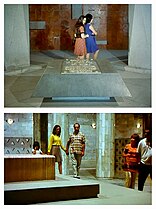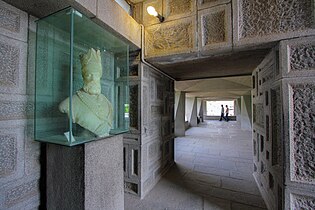| Tomb of Nader Shah | |
|---|---|
| آرامگاه نادرشاه | |
 | |
| General information | |
| Architectural style | Iranian architecture |
| Town or city | Mashhad |
| Country | |
| Completed | 1963 |
| Design and construction | |
| Architect(s) | Hooshang Seyhoun |
Tomb of Nader Shah (Persian: آرامگاه نادرشاه) is a building in Mashhad designed by Hooshang Seyhoun.
About the person
Nader Shah was born into an ordinary family from the Qirqlu branch of the Afshars, a Turkic tribe living in Khorasan. When Safavid Iran was invaded by the Afghans, he entered the service of Safavid shah Tahmasp II and was named Tahmasp Qoli Khan. Subsequently, he defeated the Afghans, the Ottomans, and the Russians in a short period of time. During this process, he strengthened his position, dethroned Tahmasp II in 1732, and proclaimed himself the regent to the new shah, Tahmasp II's infant son, Abbas III. In 1736, calling a congress in Mughan, he dethroned Abbas III and declared himself shah, ending 235-years of Safavid rule.
History
After Nader Shah's successful campaign against the Mughal Empire, he returned with immense wealth: the peacock throne, the Koh-i-Noor and Daria-i-Noor diamonds, and “700 elephants, 4,000 camels and 12,000 horses carrying wagons all laden with gold, silver and precious stones”. After the precious jewels brought from India were hidden near Kalat, Nader ordered the Mughal architects he had brought with himself to build a magnificent mausoleum for him. This mausoleum must have been in the Mughal style.
As a result of Nader Shah's assassination in 1747, the mausoleum was not completed during his lifetime. In this period, another example of architecture built in the Mughal style by Nader Shah in the city of Mashhad was called Kakh-e Khorshid meaning the Sun Palace. This mausoleum was converted into a residential palace by various tribal leaders and Nader Shah’s body remained un-commemorated until the 1960s when a concrete monument was constructed for him in the vicinity of a heavily polluted traffic intersection in Mashhad.
Interior
Despite its incomplete exterior, the interior of the Khorshid is fully refined: each doorway is decorated by miniature paintings and Mughal frescoes.
Gallery
Sources
- "Tomb of Nader Shah". Visit Nader Shah’s mausoleum in Mashhad. Retrieved 7 July 2019.
- "Tomb of Nader Shah". www.itto.org. Retrieved 31 July 2019.
- "Tomb of Nader Shah in Mashhad". www.alaedin.travel/en. Retrieved 31 July 2019.
- "Encyclopaedia of the Iranian Architectural History". Cultural Heritage, Handicrafts and Tourism Organization of Iran. 19 May 2011. Archived from the original on 6 April 2015.
- "كاخ خورشيد، نگين درخشان معماري خطه كلات". ایرنا (in Persian). 2016-03-02. Archived from the original on 2021-11-26. Retrieved 2021-11-26.
- Dalrymple, Sam. "Here lay Nader Shah". Conde Nast Traveller.
- Dalrymple, Sam. "Here lay Nader Shah". Conde Nast Traveller.











